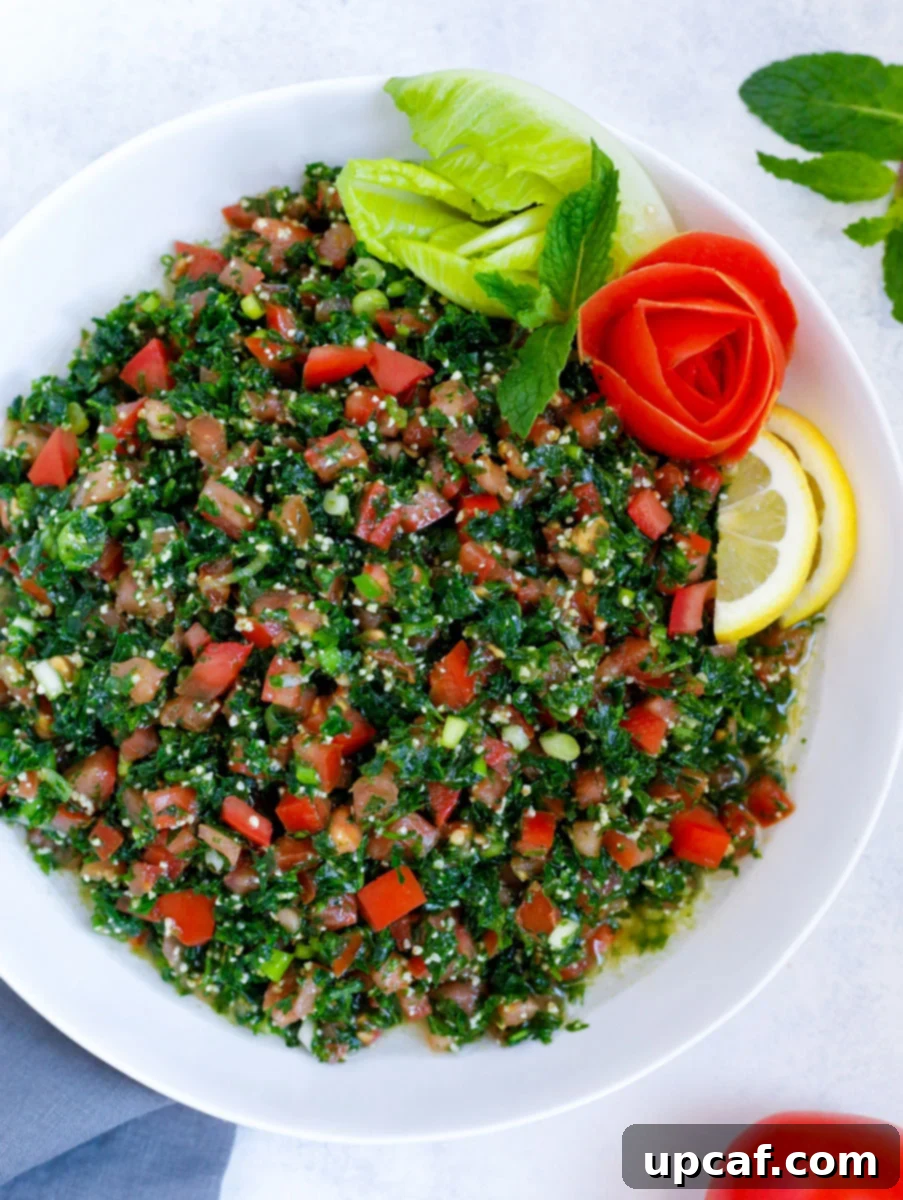Welcome to the vibrant world of Middle Eastern cuisine, where fresh ingredients come together to create unforgettable flavors. Among the many culinary treasures, the Lebanese Tabbouleh Salad stands out as a quintessential dish. More than just a salad, it’s a celebration of crisp vegetables, aromatic herbs, and bright, zesty notes, making it a beloved staple across the region and beyond. This traditional recipe is incredibly easy to prepare, relying on simple, wholesome ingredients to deliver a burst of freshness in every bite. Whether you’re a seasoned chef or a kitchen novice, you’ll find this Tabbouleh recipe approachable and rewarding. It’s not only a fantastic make-ahead dish, allowing the flavors to deepen beautifully, but it’s also wonderfully versatile. Perfect as a refreshing component of a grand mezze platter, a vibrant side dish, or a light and satisfying lunch, Lebanese Tabbouleh is truly a dish for all occasions.
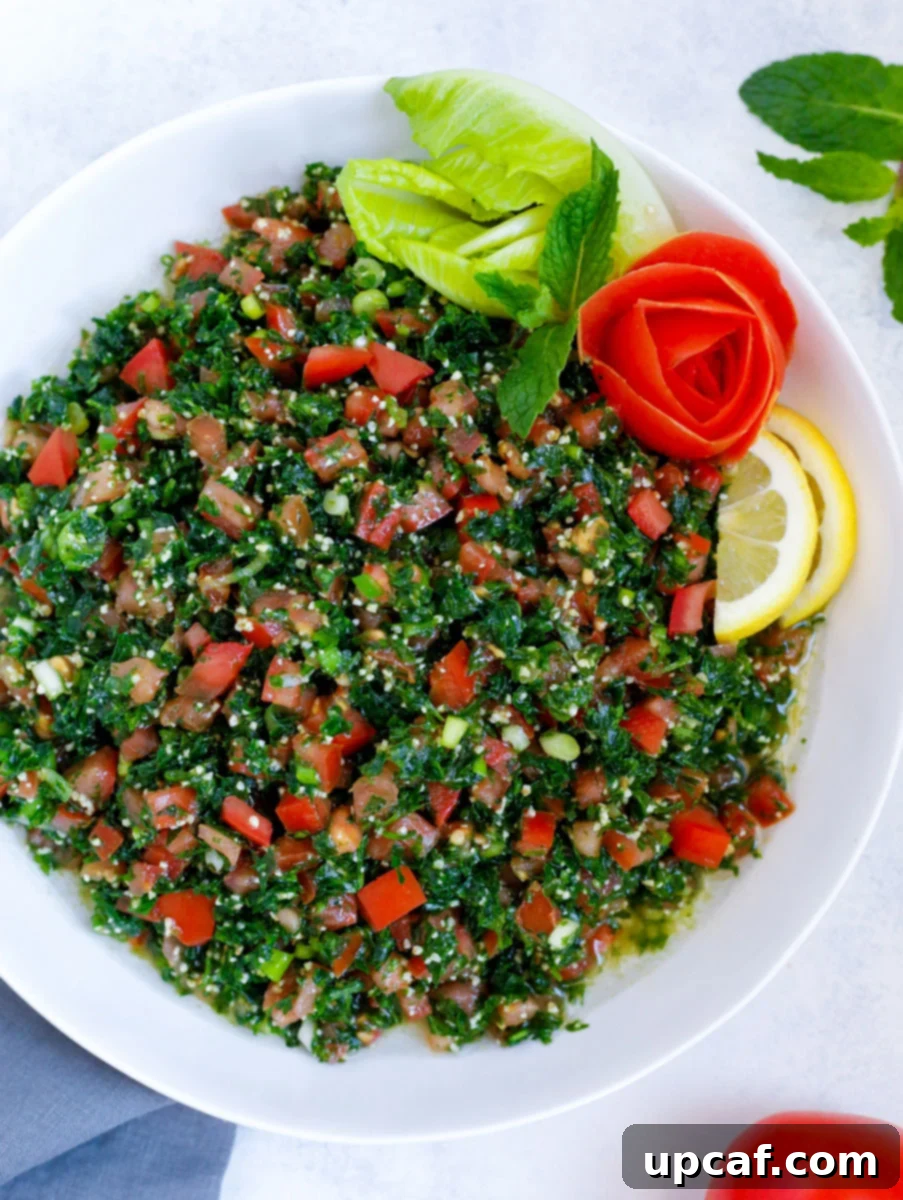
Growing up, Tabbouleh was a constant presence at our family table, and it quickly became one of my absolute favorite salads. There’s something uniquely satisfying about scooping it up with a crisp lettuce leaf, a popular and traditional way to enjoy it in Lebanon – a delightful, fresh wrap straight from nature’s bounty. Recipes like Tabbouleh, alongside its equally famous cousin Fattoush Salad, have graced Middle Eastern tables for generations, embodying the rich culinary heritage of the Levant. I often serve both these iconic salads as part of an elaborate mezze spread, complemented by savory delights such as Lebanese Spicy Potatoes (Batata Harra) and a generous portion of creamy Hummus. These dishes, when combined, offer a harmonious blend of textures and tastes, creating an authentic dining experience that celebrates the heart of Lebanese hospitality.
What is Authentic Lebanese Tabbouleh Salad?
Tabbouleh, often spelled Tabbouli, is far more than just a parsley salad; it’s a culinary icon deeply embedded in Middle Eastern culture, particularly in Lebanon. It traditionally features as a star component of a mezze, a selection of small dishes served as appetizers. At its core, Lebanese Tabbouleh is distinguished by its incredibly fine chop and a specific ratio of ingredients, where parsley takes center stage. It’s predominantly made from an abundance of finely chopped fresh parsley, complemented by diced ripe tomatoes, thinly sliced green onions, and a small amount of fine bulgur wheat that has been carefully soaked. This vibrant mixture is then generously dressed in a simple yet potent marinade of fresh lemon juice and high-quality extra virgin olive oil. While some regional variations might include fresh mint or a touch of sour grape molasses for added tang, the classic Lebanese rendition prioritizes the fresh, herbaceous flavors of parsley and mint. Being entirely plant-based, it is naturally vegan, bursting with invigorating and wholesome flavors that awaken the palate.
The Essence of Tabbouleh: Key Ingredients for Success
The secret to an extraordinary Lebanese Tabbouleh lies in the freshness and quality of its ingredients, along with precise preparation. Each component plays a crucial role in achieving that signature vibrant flavor and delightful texture. Here’s a breakdown of what you’ll need and why each choice matters:
- Fresh Parsley: This is the undisputed star of Tabbouleh, making up the bulk of the salad. For the best result, opt for flat-leaf (Italian) parsley due to its robust flavor and ease of chopping. The key here is to chop it incredibly fine, by hand. Resist the temptation to use a food processor, as it tends to bruise the parsley, releasing too much moisture and resulting in a soggy, overly minced texture that lacks the desired crispness and definition.
- Tomatoes: Choose ripe, firm vine-ripened or plum tomatoes. Their natural sweetness and juiciness provide a beautiful contrast to the herbs. Dicing them into very small, uniform pieces ensures they integrate seamlessly into the salad without overpowering other flavors.
- Bulgur: It’s essential to use fine bulgur wheat (sometimes labeled #1 or extra fine). Coarse bulgur will not achieve the desired delicate texture and may require cooking. Fine bulgur only needs soaking to soften, absorbing the delicious juices from the tomatoes and the zesty dressing.
- Green Onions: Finely chopped green onions (scallions) add a mild, pungent kick and a beautiful pop of color. Their subtle onion flavor is crucial for the salad’s overall balance, providing an aromatic depth without being too harsh.
- Fresh Lemon Juice: This is a non-negotiable ingredient. Always use freshly squeezed lemon juice. Bottled lemon juice simply doesn’t compare in terms of brightness and natural acidity, which is vital for balancing the richness of the olive oil and enhancing the freshness of the herbs.
- Extra Virgin Olive Oil: Invest in a high-quality extra virgin olive oil. It’s a primary flavor component, lending a smooth, fruity richness to the dressing. Avoid using lesser quality oils like canola or vegetable oil, as they lack the distinct flavor profile essential for authentic Tabbouleh.
- Salt: Essential for seasoning, salt brings out the flavors of all the fresh ingredients. Add it gradually and adjust to taste, ensuring it perfectly complements the lemon and olive oil.
- Fresh Mint (Optional, but highly recommended): While some recipes use dried mint, fresh mint, finely chopped, elevates the flavor profile with an additional layer of cooling freshness. If using dried mint, a smaller quantity is needed, but fresh mint truly takes it to the next level.
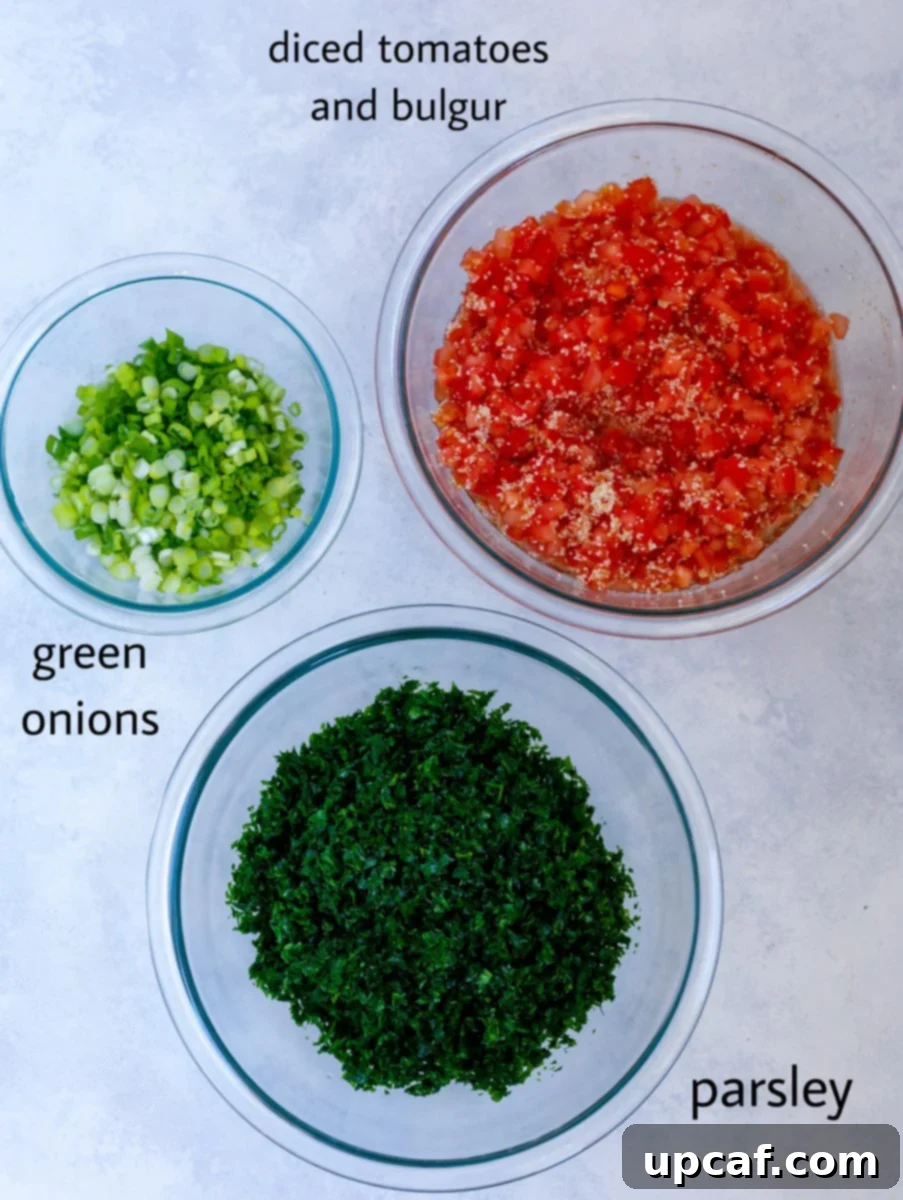
Crafting Your Lebanese Tabbouleh: A Step-by-Step Guide
Making Lebanese Tabbouleh is a joyous and straightforward process, but attention to detail, especially in the chopping, makes all the difference. Follow these steps to create a perfect, vibrant salad:
- Prepare the Tomatoes and Bulgur: Begin by washing and thoroughly drying your vine-ripened tomatoes. Using a very sharp knife, finely dice the tomatoes into small, consistent pieces. Transfer the diced tomatoes to a bowl and add the fine bulgur wheat. Gently mix them together. The natural moisture from the tomatoes will begin the process of softening the bulgur.
- Hydrate the Bulgur: Cover the bowl containing the tomatoes and bulgur and place it in the refrigerator. Allow it to sit for at least 10 minutes. This crucial step gives the bulgur time to absorb the tomato juices, softening it to the perfect al dente texture while you prepare the other components.
- Chop the Herbs and Green Onions: While the bulgur is hydrating, prepare your parsley and green onions. First, meticulously wash and dry the fresh parsley. It’s vital that the parsley is completely dry to prevent a soggy salad. Remove all stems, then gather the parsley leaves tightly and chop them very finely by hand. Place the finely chopped parsley into a large mixing bowl. Next, finely chop the green onions (both white and green parts) and add them to the parsley.
- Combine and Dress: Retrieve the chilled bowl of tomatoes and bulgur from the refrigerator. Add this mixture to the large bowl with the chopped parsley and green onions. If using, add the finely chopped fresh mint at this stage.
- Season and Toss: Pour in the fresh lemon juice and high-quality extra virgin olive oil. Sprinkle with salt, and if desired, a pinch of freshly ground black pepper. Now, gently but thoroughly toss all the ingredients together. Ensure everything is well combined and the dressing evenly coats every piece of parsley and tomato. This mixing allows the parsley to absorb the flavorful dressing, enhancing the overall taste.
- Serve and Enjoy: For optimal flavor, allow the Tabbouleh to rest for another 15-30 minutes in the refrigerator before serving, allowing the flavors to meld beautifully. Serve your fresh Lebanese Tabbouleh with crisp lettuce leaves, pita bread, or as a side to your favorite grilled dishes.
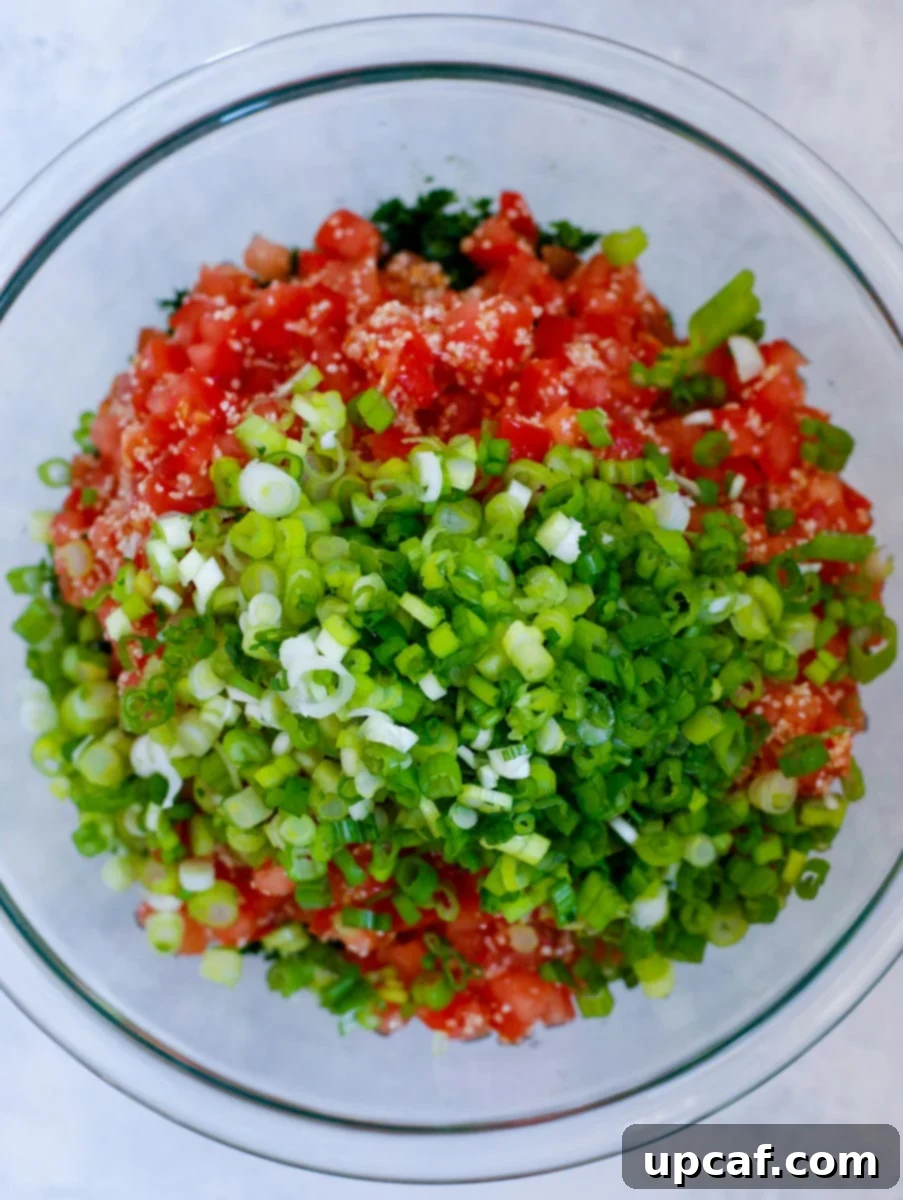
Expert Tips for Crafting the Perfect Tabbouleh
Achieving that authentic, restaurant-quality Tabbouleh at home is simpler than you think, especially when you keep these key tips in mind:
- Allow Bulgur to Hydrate Properly: The initial step of letting the fine bulgur and diced tomatoes sit together in the fridge for at least 10 minutes is crucial. This period allows the bulgur to soften perfectly by absorbing the natural moisture from the tomatoes, ensuring it’s tender yet retains a slight bite, contributing to the salad’s delightful texture.
- Hand Chop, Don’t Process: This is perhaps the most important rule for Tabbouleh. All ingredients, especially the parsley, must be finely chopped by hand. Using a food processor will bruise the herbs and vegetables, leading to excessive moisture release and a pulpy, rather than crisp, texture. The goal is distinct, fine pieces, not a pesto-like consistency.
- Thoroughly Dry Your Parsley: Before chopping, ensure your parsley is completely dry. Excess water will dilute the dressing and make the salad soggy. After washing, use a salad spinner or pat the parsley dry with paper towels, then remove all thick stems.
- Employ a Sharp Knife: A sharp knife is your best friend when making Tabbouleh. It allows for clean, precise cuts, making the chopping process much easier and preventing the ingredients from being squashed or bruised. This is particularly important for achieving uniform parsley pieces.
- Opt for Fresh, Firm Produce: The quality of your vegetables directly impacts the final taste and texture. Choose fresh, firm tomatoes, vibrant green onions, and crisp parsley. High-quality ingredients contribute to a more flavorful and visually appealing salad with that desirable “crispy” bite.
- Don’t Over-mix: Once all ingredients and the dressing are combined, toss gently. Over-mixing can bruise the parsley and make the salad watery. The aim is just enough mixing to evenly distribute the dressing.
- Allow Flavors to Marry: While delicious immediately, Tabbouleh truly shines after it has had some time to rest. Allowing it to chill in the refrigerator for at least 30 minutes (or even longer) before serving allows the flavors to meld and deepen, creating a more harmonious and complex taste experience.
Frequently Asked Questions About Tabbouleh
How long does Lebanese Tabbouleh keep?
Unlike some other fresh salads like Fattoush, Tabbouleh actually holds up remarkably well in the refrigerator, and many find that the flavors deepen and become even more harmonious after a day or so. Store the salad in an airtight container, and it can remain fresh and delicious for up to 3 days. If you’re planning to prepare the salad ahead of time for a special occasion, a helpful trick is to place the diced tomatoes at the very bottom of the bowl and keep the lemon-oil dressing separate. Mix everything together just a few hours before serving to maintain optimal freshness and texture.
Is Tabbouleh gluten-free?
Traditional Tabbouleh, made with bulgur wheat, is not gluten-free, as bulgur is a derivative of wheat. However, if you have a gluten intolerance or are simply looking for an alternative, several excellent substitutes exist. Quinoa is a fantastic option; its similar size and texture make it a popular gluten-free alternative that performs very well in Tabbouleh. Millet is another great choice. When using quinoa, ensure it is certified gluten-free if you are highly sensitive, to avoid cross-contamination. Simply cook your chosen gluten-free grain according to package directions, then allow it to cool completely before incorporating it into the salad in place of bulgur.
What are the best ways to serve Tabbouleh?
Tabbouleh is incredibly versatile and can be enjoyed in numerous ways. It excels as a refreshing salad on its own, a vibrant side dish, or a sophisticated appetizer. I love preparing a large, beautiful bowl for the table, allowing everyone to help themselves and experience its fresh appeal. Traditionally, it’s served in crisp lettuce leaves (such as romaine or butter lettuce), which act as natural, edible cups for scooping. It also makes a fantastic filling for pita bread, wraps, or even as a topping for sandwiches. For a complete meal, I often pair Tabbouleh with grilled proteins like succulent Chili Lime Shrimp, tender Shish Kabobs, grilled chicken, or even alongside hearty falafel. Its bright, acidic profile cuts through richness and complements a wide range of main courses, making it a perfect companion to nearly any meal.
What type of parsley is best for Tabbouleh?
For authentic Lebanese Tabbouleh, flat-leaf parsley (also known as Italian parsley) is highly recommended. Its robust flavor and flat leaves are easier to chop very finely compared to curly parsley, which can be tougher and hold more water. The intense green color and slightly peppery taste of flat-leaf parsley are essential for the salad’s signature profile.
Can I use a food processor for chopping Tabbouleh ingredients?
While a food processor might seem like a time-saver, it’s strongly advised against using one for Tabbouleh, especially for the parsley. A food processor tends to bruise the delicate parsley leaves, releasing bitter juices and turning the herbs into a soggy, pulpy mass rather than distinct, fine pieces. This significantly compromises the texture and overall freshness of the salad. For truly authentic and crisp Tabbouleh, the hand-chopping method is indispensable. It ensures the ingredients maintain their structure and vibrant qualities.
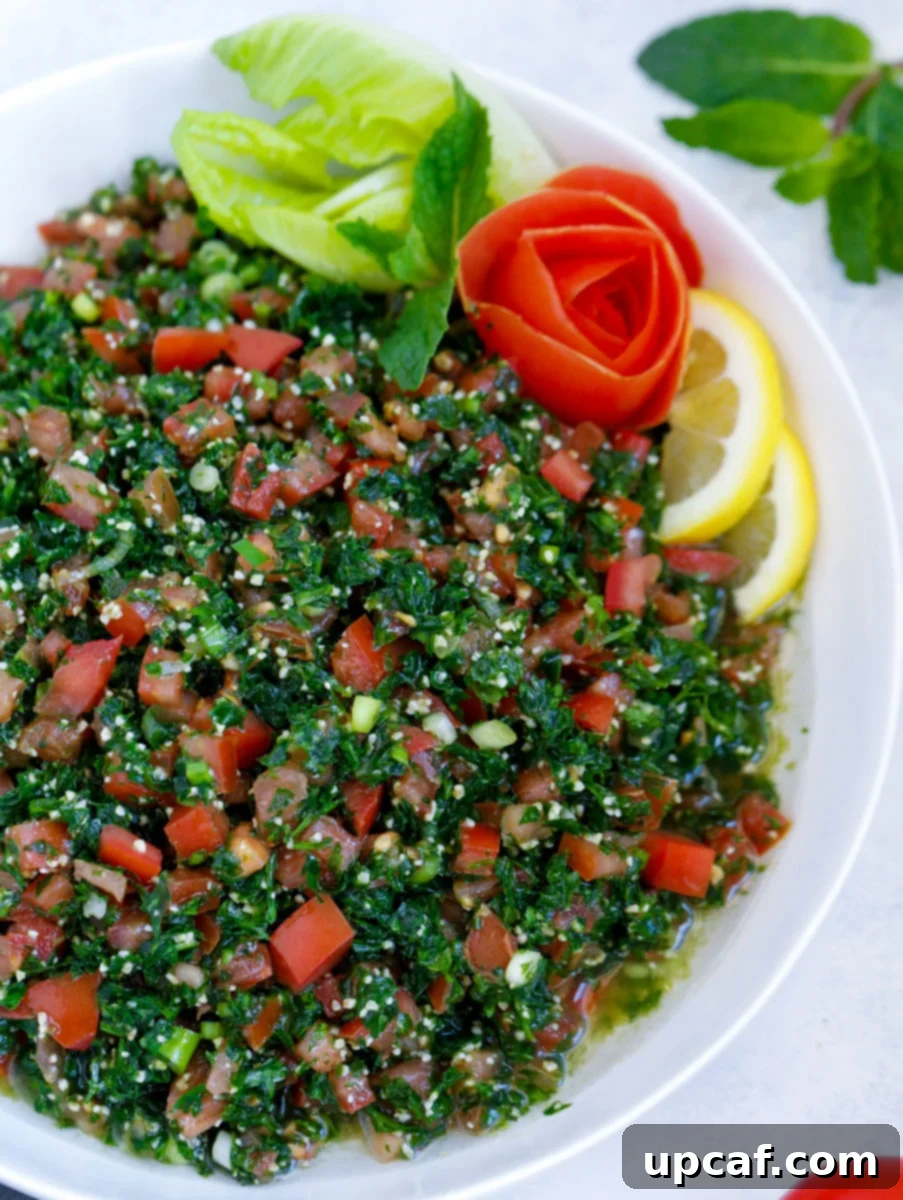
Explore More Delicious Salad Recipes
- Greek Orzo Salad
- Taco Ranch Pasta Salad
- Strawberry Spinach Salad
We genuinely hope you enjoy creating and savoring this authentic Lebanese Tabbouleh Salad, along with all the other delightful recipes we share. There’s immense joy in preparing a dish that is both simple and profoundly flavorful. We encourage you to try this recipe, experience its incredible freshness, rate it, and share your culinary creations with your friends and family. Your feedback and enthusiasm inspire us to keep sharing the best of our kitchen with you!
To stay updated with our latest culinary adventures and receive all new recipes straight to your inbox, don’t forget to sign up for our blog newsletter. We also love seeing your delicious recreations – be sure to tag us on INSTAGRAM! Until our next recipe, happy cooking. XoXo…
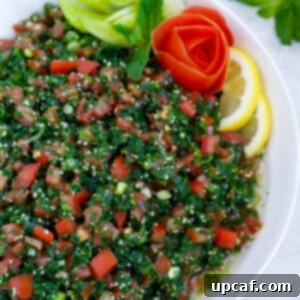
Pin Recipe
Print Recipe
Lebanese Tabbouleh Recipe
Mariam Ezzeddine
30 minutes
0 minutes
30 minutes
6 servings
Ingredients
- 3 cups fresh parsley, finely chopped
- 2 cups vine ripe tomatoes, petite diced
- 2 tbsp fine bulgur
- 1 cup green onion, finely chopped
- 1/2 cup lemon juice
- 1/2 cup extra virgin olive oil
- 1 tsp salt
- 1 tbsp dried mint (optional, or 1/4 cup freshly chopped mint)
Instructions
- Wash and thoroughly dry all the vegetables. Ensure parsley stems are removed and discarded.
- Note: Measure all ingredients accurately after chopping for precise ratios.
- Using a very sharp knife, dice the tomatoes into small, consistent pieces. Place them in a bowl with the fine bulgur and mix gently.
- Cover the bowl and refrigerate for at least 10 minutes. This allows the bulgur to soften by absorbing the tomato juices while you prepare other ingredients.
- Finely chop the parsley by hand, ensuring it’s as fine as possible without bruising. Finely chop the green onions (white and green parts). Combine parsley and green onions in a large mixing bowl.
- Add the chilled tomato and bulgur mixture to the large bowl with the herbs.
- Add the lemon juice, salt, and extra virgin olive oil to the Tabbouleh bowl. If using fresh mint, add it now.
- Gently toss all ingredients together very well until evenly combined and the parsley has absorbed the dressing.
- For best results, let the salad chill for another 15-30 minutes before serving. Serve with crisp lettuce leaves or as a side dish.
Notes
- Bulgur Hydration: Allowing the bulgur and tomato mixture to rest for at least 10 minutes in the fridge is essential for the bulgur to soften and absorb flavors.
- Hand Chopping is Key: Never use a food processor for parsley; it will become soggy. All ingredients should be finely chopped by hand for the ideal texture.
- Dry Parsley: Ensure parsley is thoroughly dry before chopping, and remove all stems.
- Sharp Knife: A sharp knife makes chopping easier and prevents bruising of delicate ingredients.
- Fresh Vegetables: Use fresh, firm vegetables for a crispier, more flavorful salad.
- Storage: The salad keeps well in an airtight container in the fridge for up to 3 days, often tasting better the next day.
Nutrition
Calories:
206
kcal
|
Carbohydrates:
10
g
|
Protein:
2
g
|
Fat:
18
g
|
Saturated Fat:
3
g
|
Sodium:
412
mg
|
Potassium:
371
mg
|
Fiber:
3
g
|
Sugar:
2
g
|
Vitamin A:
3135
IU
|
Vitamin C:
58
mg
|
Calcium:
64
mg
|
Iron:
3
mg
Like this recipe? Rate and comment below!
